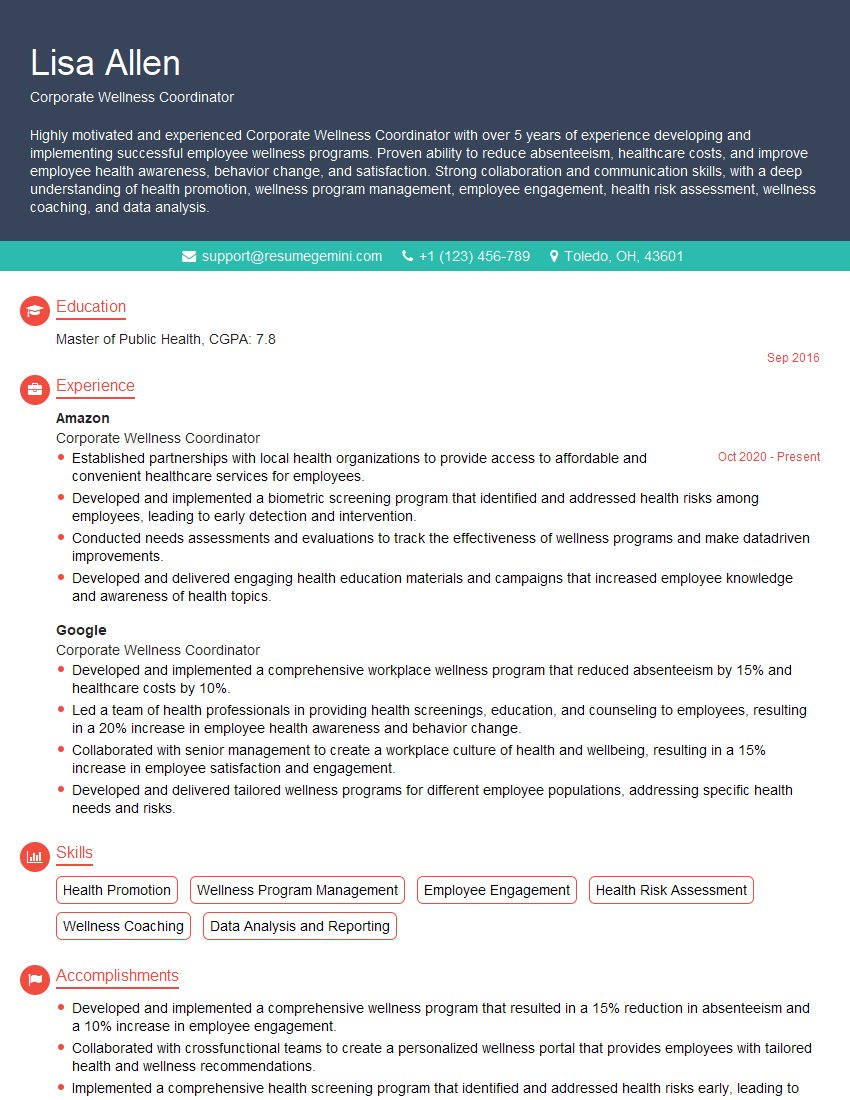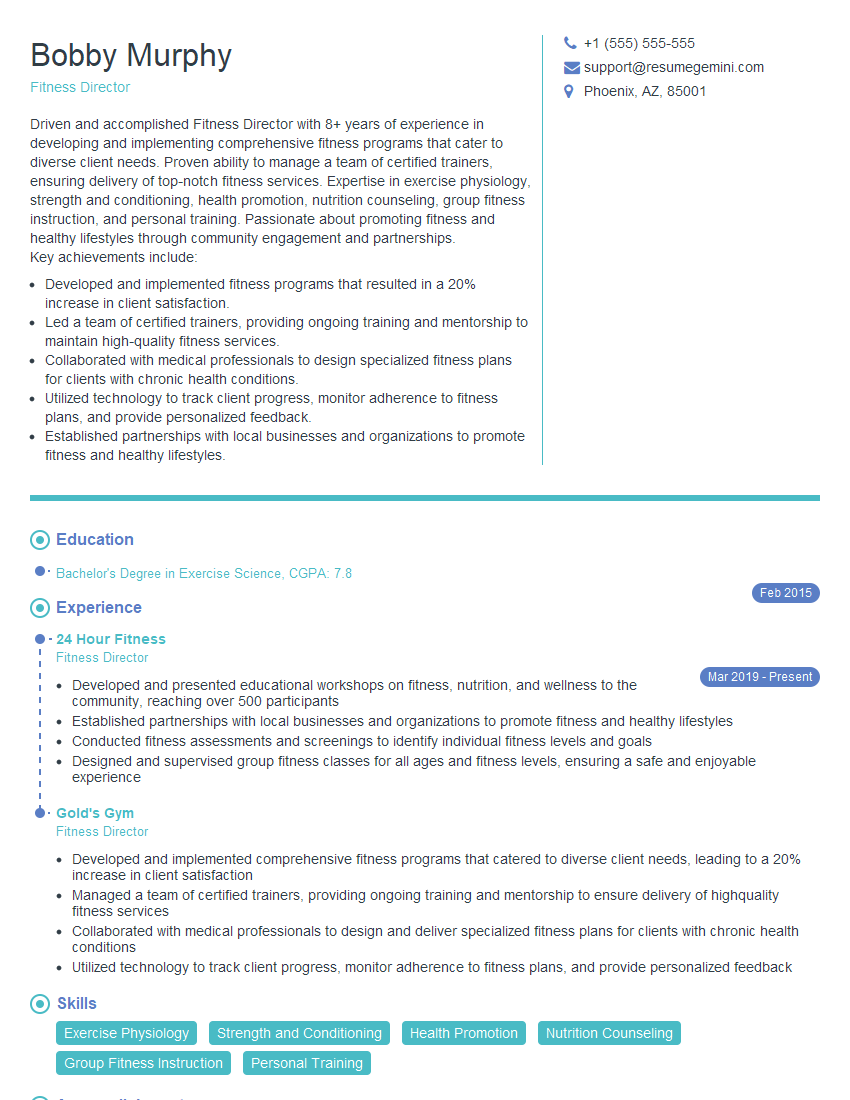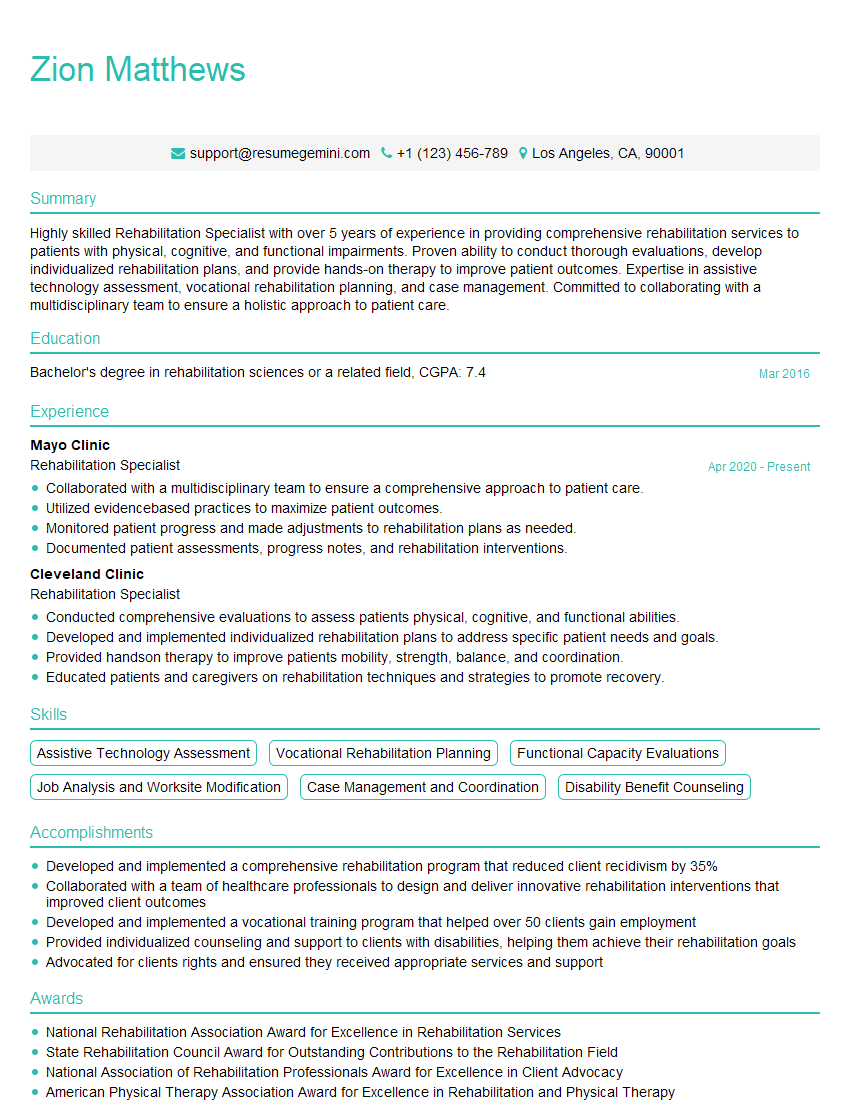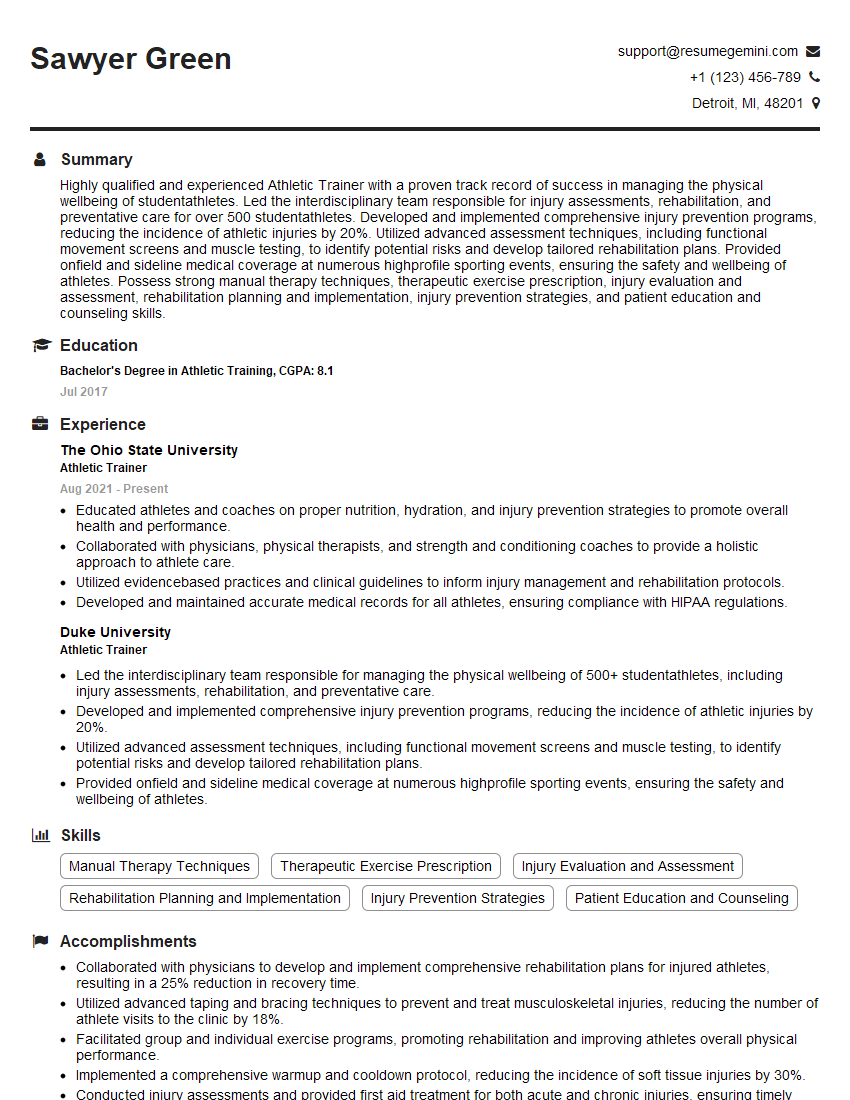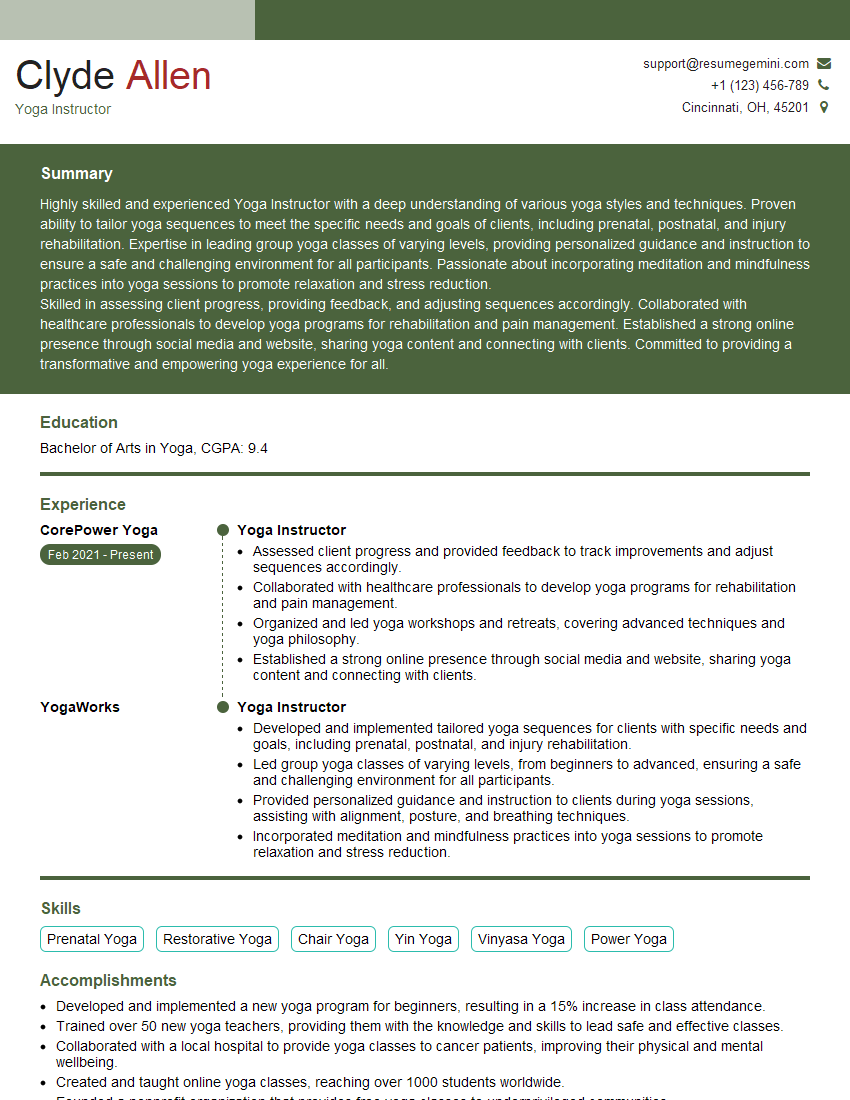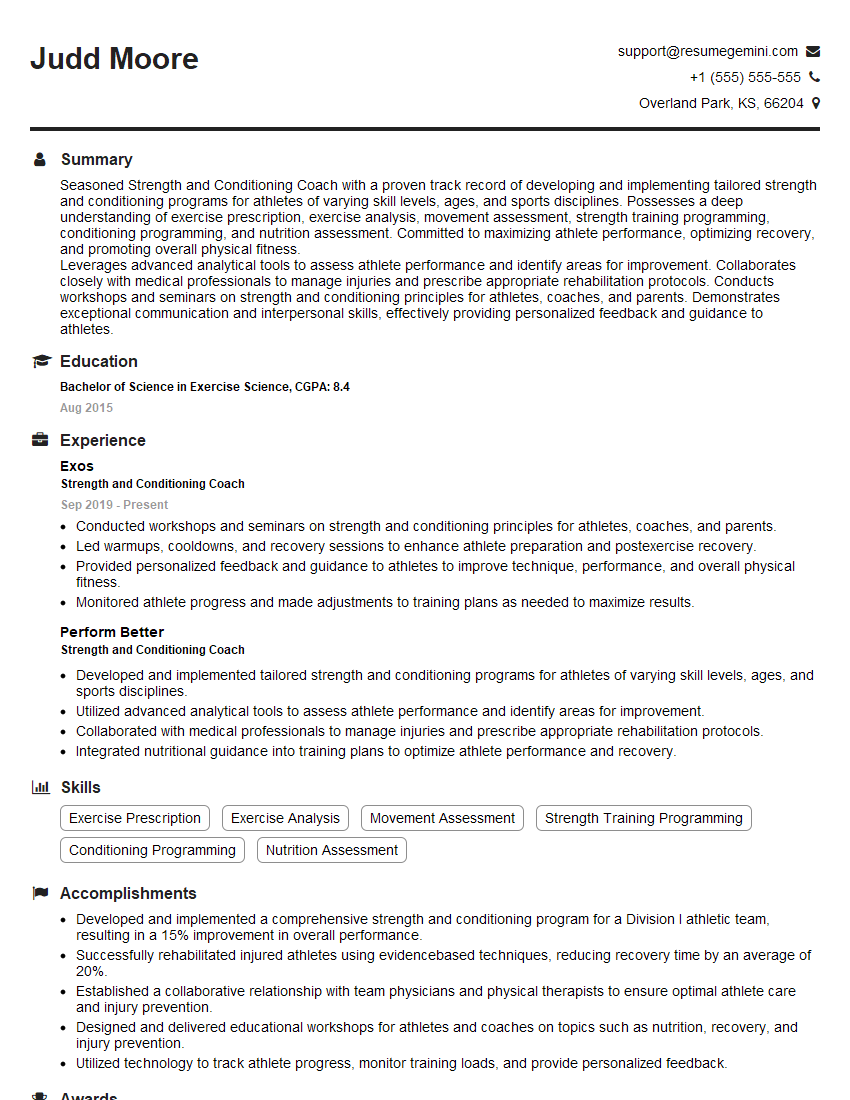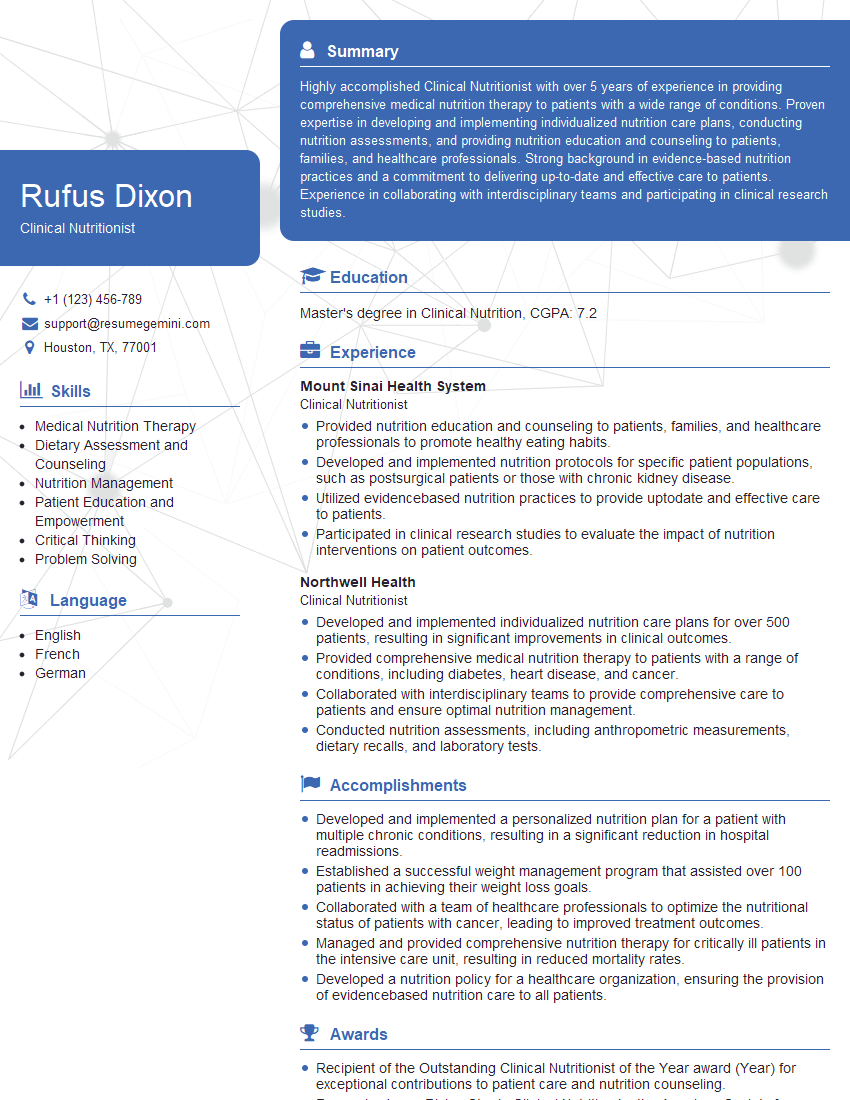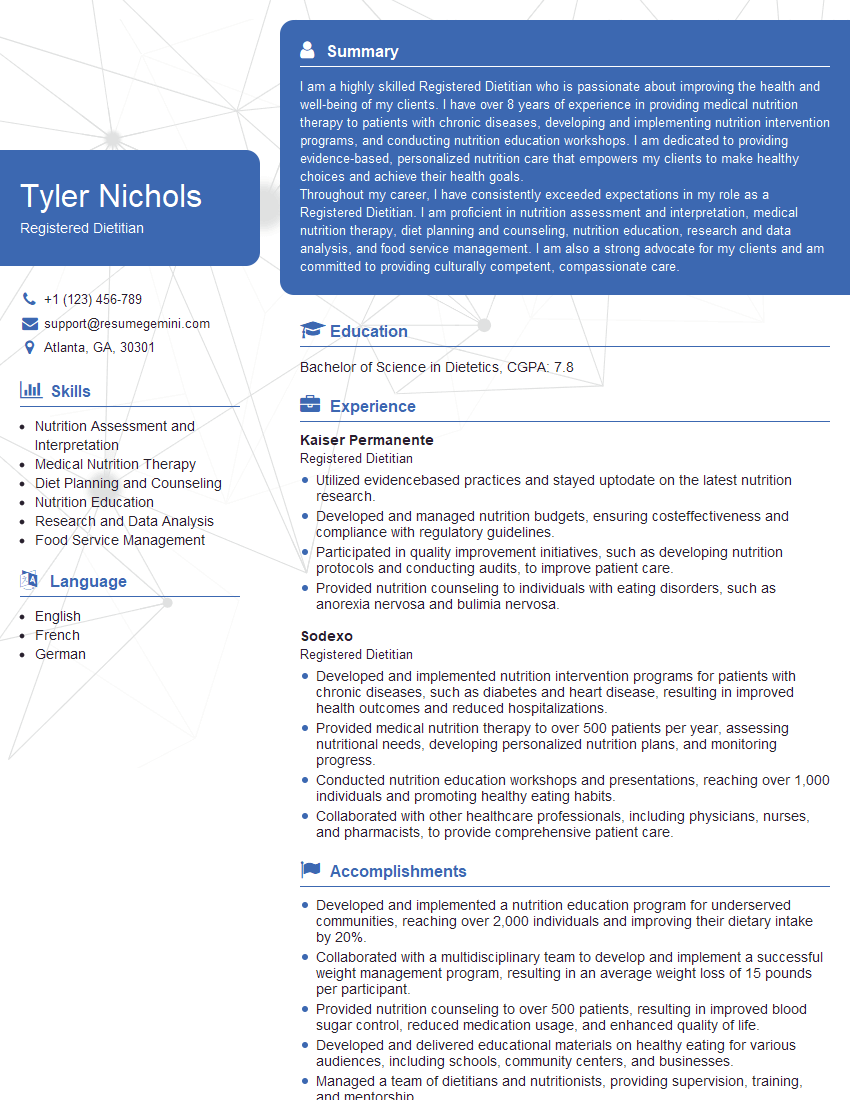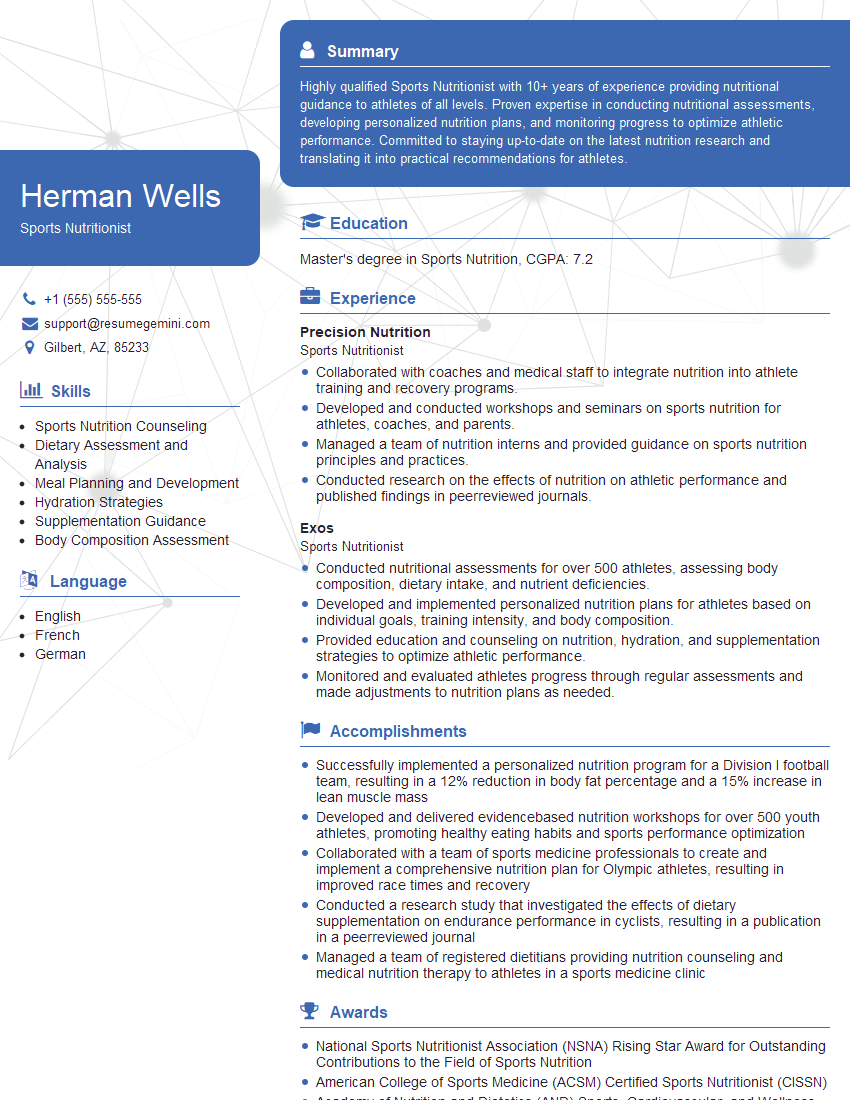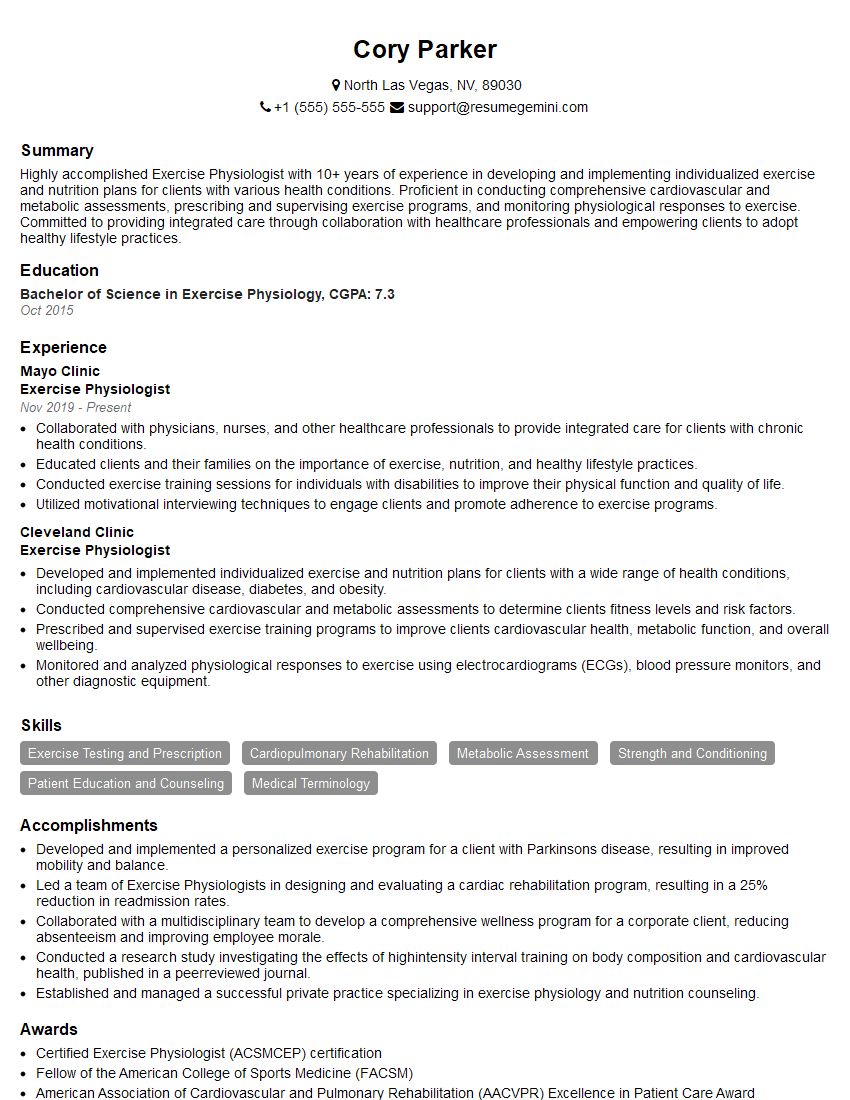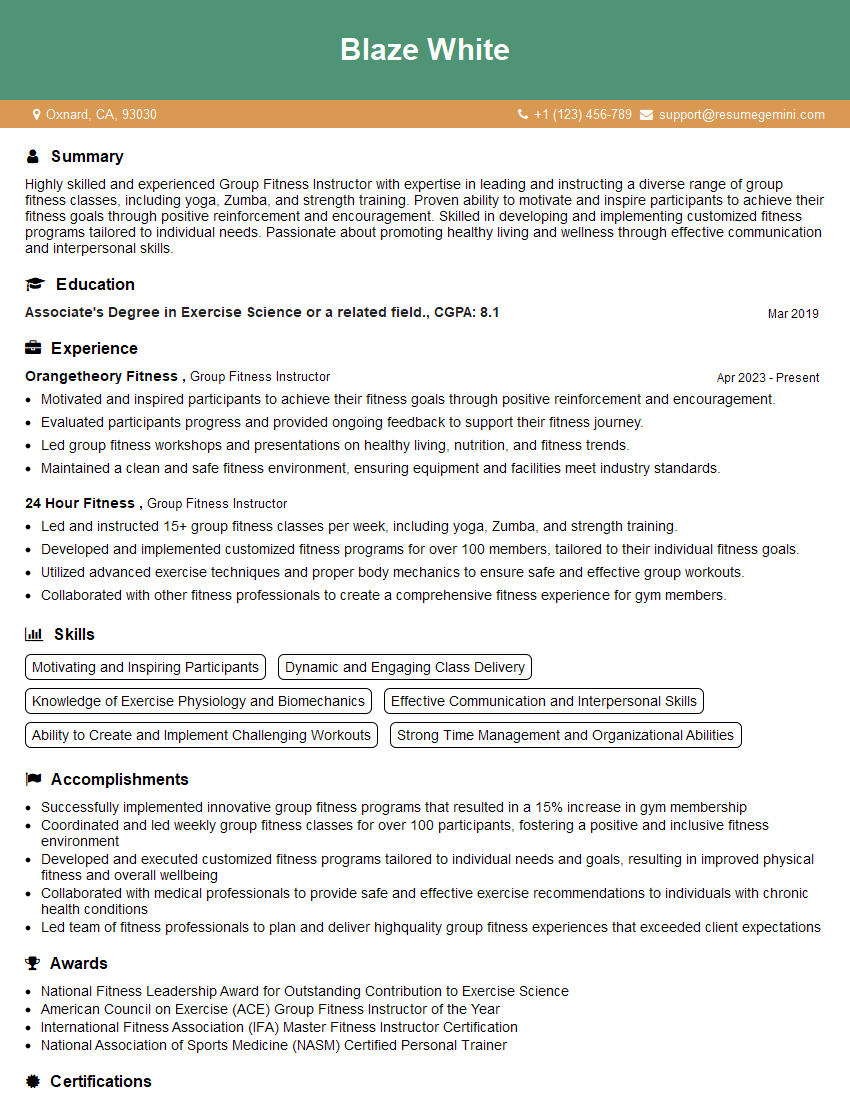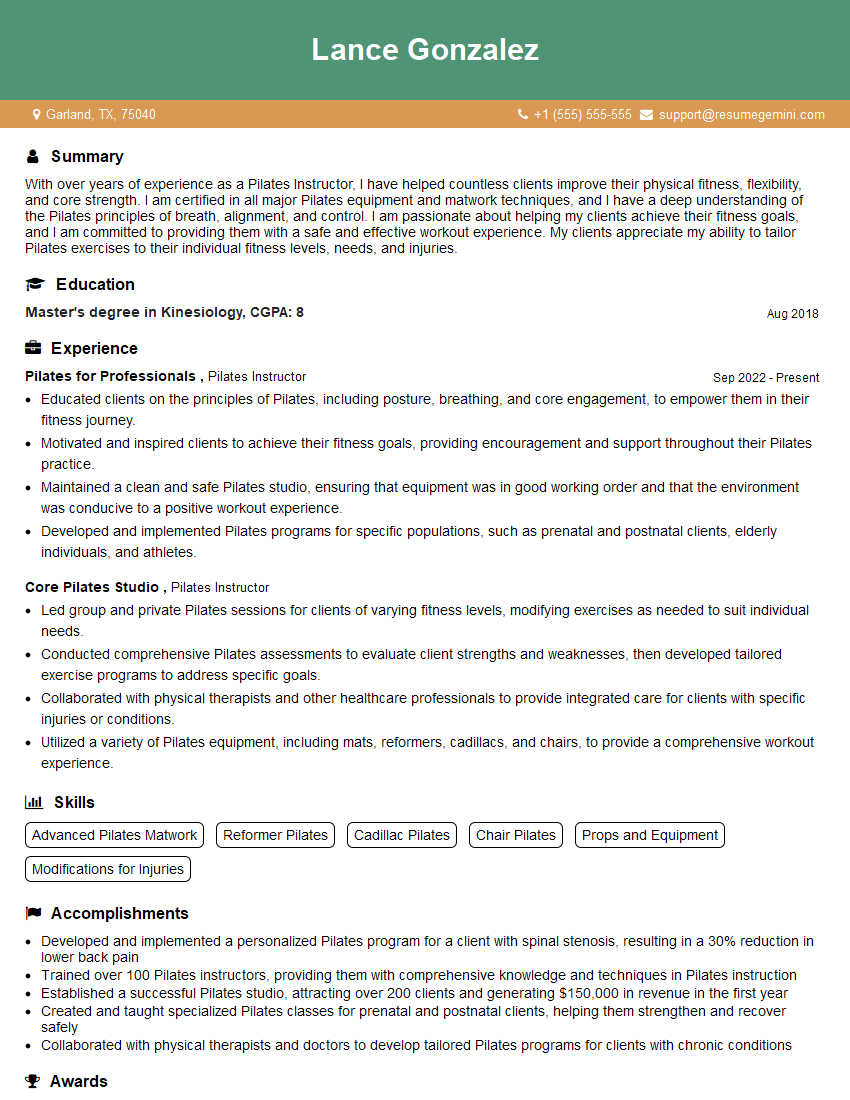Interviews are more than just a Q&A session—they’re a chance to prove your worth. This blog dives into essential Physical Conditioning and Nutrition interview questions and expert tips to help you align your answers with what hiring managers are looking for. Start preparing to shine!
Questions Asked in Physical Conditioning and Nutrition Interview
Q 1. Explain the difference between Type I and Type II muscle fibers.
Skeletal muscle fibers are categorized into two main types: Type I and Type II, each possessing distinct metabolic and contractile properties. Think of them as two different engines in your body, each suited for a specific task.
- Type I (Slow-twitch) fibers: These are endurance champions. They’re smaller in diameter, contain more mitochondria (the powerhouses of the cell), and are rich in myoglobin (which stores oxygen). They contract slowly but resist fatigue for extended periods. Think of a marathon runner’s legs – primarily relying on Type I fibers for prolonged activity.
- Type II (Fast-twitch) fibers: These are powerhouses, built for speed and strength. Larger in diameter and containing fewer mitochondria, they generate rapid, powerful contractions but fatigue quickly. Think of a sprinter’s powerful leg muscles – predominantly Type II fibers enabling bursts of intense activity. Type II fibers are further subdivided into Type IIa (intermediate) and Type IIx (fast glycolytic), each with slightly different characteristics in terms of speed and fatigue resistance.
Understanding this distinction is crucial in designing effective training programs. Endurance training promotes Type I fiber development, while strength training increases Type II fiber size and power output.
Q 2. Describe the role of macronutrients (carbohydrates, proteins, and fats) in athletic performance.
Macronutrients – carbohydrates, proteins, and fats – are essential for athletic performance, each playing a unique role in fueling the body and promoting recovery.
- Carbohydrates: The primary fuel source for high-intensity exercise. They are broken down into glucose, providing readily available energy. Sufficient carbohydrate intake is crucial for replenishing glycogen stores (stored glucose) in muscles and liver, preventing fatigue and ensuring optimal performance.
- Proteins: Essential for building and repairing muscle tissue, critical for athletes undergoing rigorous training. Protein also plays a role in hormone production and immune function, both vital for recovery and overall health.
- Fats: A significant energy source for lower-intensity, longer-duration exercise. They also provide essential fatty acids, vital for hormone production, cell function, and overall health. Fats contribute to satiety, helping manage appetite and overall calorie intake.
The optimal ratio of these macronutrients varies greatly depending on the individual’s sport, training intensity, and energy needs. A balanced approach, individualized to the athlete’s specific demands, is always recommended.
Q 3. What are the key considerations for designing a nutrition plan for a marathon runner?
Designing a nutrition plan for a marathon runner requires a meticulous approach focused on fueling both training and recovery.
- Carbohydrate Loading: Strategically increasing carbohydrate intake in the days leading up to the race to maximize glycogen stores. This ensures sufficient energy reserves for the marathon distance.
- Hydration Strategy: Maintaining adequate hydration throughout the training cycle and particularly during the race. Dehydration can significantly impact performance.
- Electrolyte Balance: Replenishing electrolytes (sodium, potassium, etc.) lost through sweat to prevent muscle cramps and maintain optimal function.
- Nutrient Timing: Consuming carbohydrates and protein around workouts to optimize glycogen replenishment and muscle repair. Pre- and post-run nutrition is crucial.
- Individualized Caloric Needs: Calculating energy expenditure and adjusting caloric intake to match the demands of training and maintain a healthy body weight.
Working with a registered dietitian is highly recommended to create a personalized plan that caters to the runner’s individual needs, training schedule, and any dietary restrictions.
Q 4. Outline the principles of periodization in strength training.
Periodization in strength training is a systematic approach to programming that divides training into distinct cycles (macrocycles, mesocycles, microcycles) to optimize gains while minimizing risk of overtraining and injury. Think of it as building a house; you wouldn’t build the roof before the foundation.
- Macrocycle: The longest cycle, often an entire year, encompassing the overall training goal (e.g., peak performance for a competition).
- Mesocycle: Shorter periods within the macrocycle, focusing on specific training phases (e.g., hypertrophy, strength, power). Each mesocycle builds upon the previous one.
- Microcycle: The shortest cycle, typically one week, detailing daily or weekly training plans.
Key principles include: varying training volume and intensity across cycles, incorporating periods of rest and recovery, and strategically manipulating exercise selection to target specific adaptations. For example, a strength training program might start with a hypertrophy phase (high volume, moderate intensity), followed by a strength phase (moderate volume, high intensity), and finally a power phase (low volume, very high intensity), each building progressively towards the athlete’s primary goal.
Q 5. Explain the concept of VO2 max and its importance in fitness assessment.
VO2 max, or maximal oxygen consumption, represents the maximum amount of oxygen your body can utilize during intense exercise. It’s a crucial indicator of cardiorespiratory fitness. Imagine it as the engine’s horsepower in your cardiovascular system.
A higher VO2 max indicates greater aerobic capacity, meaning you can sustain high-intensity exercise for longer periods. It’s assessed through graded exercise tests, usually on a treadmill or stationary bike, measuring oxygen uptake at progressively increasing workloads. The test measures how efficiently your body uses oxygen to produce energy during exercise.
VO2 max is vital in fitness assessment because it provides objective data on cardiorespiratory fitness levels. It’s used to monitor training progress, set realistic goals, and assess an individual’s risk of cardiovascular disease. Knowing your VO2 max can help you design appropriate training programs and track your progress effectively.
Q 6. How would you assess a client’s body composition?
Assessing body composition, which is the proportion of fat mass to fat-free mass (muscle, bone, water), requires a multi-faceted approach. No single method is perfect.
- Skinfold Calipers: This involves measuring the thickness of subcutaneous fat at various body sites using calibrated calipers. This method is relatively inexpensive and portable, but accuracy depends on the technician’s skill and experience.
- Bioelectrical Impedance Analysis (BIA): This method uses a weak electrical current to estimate body fat percentage based on the resistance of the tissues. It’s easy to use but can be influenced by factors like hydration levels and recent food intake.
- Underwater Weighing (Hydrostatic Weighing): This ‘gold standard’ method involves submerging the individual underwater to measure body density. It’s highly accurate but requires specialized equipment and trained personnel.
- DEXA Scan (Dual-energy X-ray absorptiometry): This advanced imaging technique provides a highly accurate assessment of body composition, including bone density. It’s expensive and requires specialized equipment.
The choice of method depends on factors such as cost, availability, and required precision. A combination of methods often provides a more reliable assessment. It’s also crucial to consider individual factors and interpret results within a broader context of health and fitness goals.
Q 7. What are the signs and symptoms of overtraining?
Overtraining, a state of excessive training without adequate recovery, can significantly impair performance and lead to various health issues. Think of it as your body’s ‘overdraft’ warning.
Signs and Symptoms:
- Persistent Fatigue: Feeling unusually tired and unable to recover even with adequate rest.
- Decreased Performance: Noticeable decline in performance despite consistent training.
- Increased Resting Heart Rate: Heart rate remains elevated even during periods of rest.
- Muscle Soreness: Prolonged and unusual muscle soreness that doesn’t improve with rest.
- Sleep Disturbances: Difficulty falling asleep, frequent awakenings, or poor quality sleep.
- Mood Changes: Increased irritability, anxiety, or depression.
- Loss of Motivation: Decreased interest in training and competition.
- Increased Susceptibility to Illness: More frequent colds or other infections.
If you suspect overtraining, it’s crucial to reduce training volume and intensity, prioritize rest and recovery, and consult with a healthcare professional or certified coach to address the issue before it leads to serious health consequences. Remember, adequate rest is just as important as training itself!
Q 8. Describe the importance of hydration in physical performance.
Hydration is absolutely crucial for optimal physical performance. Water is the primary component of our bodies, playing a vital role in numerous physiological processes, including regulating body temperature, transporting nutrients, and lubricating joints. During exercise, we lose water through sweat, and inadequate hydration can lead to decreased performance and even serious health consequences.
Think of your body like a finely tuned engine. If you don’t keep it properly lubricated, it’s going to sputter and eventually fail. Dehydration reduces blood volume, decreasing the efficiency of oxygen delivery to muscles. This results in fatigue, decreased endurance, and increased risk of muscle cramps. Even mild dehydration (as little as 2% loss of body weight through sweat) can significantly impair athletic performance.
Practical Application: Always stay ahead of your thirst. Before, during, and after exercise, consume plenty of water or electrolyte-rich beverages to maintain proper hydration. The amount needed depends on factors like intensity, duration, climate, and individual sweat rate. Consider using a hydration strategy that includes pre-hydration, hydration during activity, and post-hydration to replenish fluids.
Q 9. Explain the role of micronutrients in overall health and athletic performance.
Micronutrients, including vitamins and minerals, are essential for overall health and athletic performance, even though they’re needed in smaller amounts compared to macronutrients (carbohydrates, proteins, and fats). They act as catalysts for many metabolic processes, supporting energy production, immune function, muscle repair, and bone health. Deficiencies can severely impact athletic performance and overall well-being.
- Vitamins: Vitamin D is crucial for calcium absorption and bone health; B vitamins are vital for energy metabolism; Vitamin C supports immune function and collagen synthesis.
- Minerals: Iron is essential for oxygen transport; Calcium and magnesium are critical for muscle function and bone health; Zinc plays a role in immune function and protein synthesis.
Example: An athlete deficient in iron may experience anemia, leading to fatigue and reduced endurance. A deficiency in calcium can compromise bone strength, increasing the risk of fractures. A balanced diet rich in fruits, vegetables, whole grains, and lean protein is the best way to ensure adequate micronutrient intake. Supplementation may be necessary in cases of deficiency or increased needs due to intense training, but it’s always best to consult with a registered dietitian or sports nutritionist.
Q 10. How would you design a workout program for a client with osteoarthritis?
Designing a workout program for a client with osteoarthritis requires a careful and individualized approach, prioritizing low-impact exercises that minimize stress on the affected joints while maintaining strength and flexibility.
- Assessment: Begin with a thorough assessment of the client’s current physical condition, including the location and severity of osteoarthritis, range of motion, pain levels, and overall fitness level.
- Low-Impact Activities: Focus on activities like swimming, cycling, walking, and water aerobics. These are gentle on the joints but still provide cardiovascular benefits and muscle strengthening.
- Strength Training: Incorporate light resistance training using bodyweight exercises or light weights. Focus on exercises that strengthen muscles surrounding the affected joints, providing stability and support.
- Range of Motion Exercises: Include regular stretching and range-of-motion exercises to maintain joint flexibility and prevent stiffness. These should be performed slowly and gently, avoiding any pain.
- Proper Form and Progression: Emphasize proper form and gradual progression to avoid injury. Start with short durations and low intensity, gradually increasing the intensity and duration as the client’s tolerance improves.
- Rest and Recovery: Adequate rest and recovery are crucial to allow the body to repair and rebuild tissue. Listen to your body and take rest days when needed.
Example Workout: A sample workout might include 15-20 minutes of swimming, followed by 10-15 minutes of light weight training focusing on legs and arms, and concluding with 5-10 minutes of gentle stretching. This needs to be personalized to the individual’s capabilities and should be supervised by a qualified professional.
Q 11. What are the potential risks and benefits of using creatine supplements?
Creatine is a naturally occurring compound found in muscle tissue, and supplementation is popular among athletes seeking to enhance strength and power. While it offers potential benefits, there are also risks to consider.
Benefits: Creatine supplementation can increase muscle creatine stores, leading to improved muscle strength, power output, and high-intensity exercise performance. It can also promote muscle growth (hypertrophy).
Risks: The most common side effects are mild and include weight gain (due to water retention) and gastrointestinal distress (such as nausea, cramping, and diarrhea). More serious side effects are rare but include kidney problems, though this is generally only a risk for individuals with pre-existing kidney conditions.
Important Considerations: Creatine supplementation should be approached cautiously. It is generally considered safe for healthy individuals when used as directed, but individuals with kidney problems or other health conditions should consult a doctor before using it. Proper hydration is crucial when taking creatine supplements due to its water-retaining effects.
Q 12. Discuss the importance of proper warm-up and cool-down routines.
Proper warm-up and cool-down routines are essential components of any workout program. They help prepare the body for exercise and aid in recovery afterward, minimizing the risk of injury and enhancing performance.
Warm-up: This phase gradually increases heart rate, blood flow to muscles, and joint mobility. It usually involves light cardio, like jogging or cycling, followed by dynamic stretching (stretches that involve movement, such as arm circles or leg swings). The goal is to prepare your body for the more intense work ahead, like priming a machine before operation.
Cool-down: This involves light cardio followed by static stretching (holding a stretch for a period of time). It helps to gradually reduce heart rate and blood pressure, improve flexibility, and flush out metabolic waste products from muscles, promoting faster recovery. Cool-down is crucial to bring your body back to a state of rest and prepare it for the next day.
Example: A 10-minute warm-up could include 5 minutes of light cardio and 5 minutes of dynamic stretching. A 5-10 minute cool-down could include 2-5 minutes of light cardio and 5-7 minutes of static stretching. Always listen to your body and adjust the duration and intensity based on your individual needs and the type of workout.
Q 13. How would you counsel a client on healthy eating habits?
Counseling a client on healthy eating habits involves a holistic approach focusing on sustainable lifestyle changes rather than quick fixes. It’s about creating a positive relationship with food, not about restriction.
- Assessment: Start by understanding the client’s current eating habits, preferences, lifestyle, and any potential barriers to healthy eating.
- Personalized Plan: Create a personalized plan based on their individual needs and preferences. This might involve gradual changes to their diet, focusing on increasing consumption of fruits, vegetables, whole grains, and lean protein while reducing processed foods, sugary drinks, and unhealthy fats.
- Education: Educate them on the importance of macronutrients and micronutrients, portion control, and mindful eating.
- Practical Strategies: Provide practical strategies, such as meal prepping, planning grocery shopping, and reading food labels.
- Support and Motivation: Offer ongoing support and motivation, helping them to overcome challenges and celebrate their progress.
- Realistic Goals: Set realistic, achievable goals, focusing on long-term sustainability rather than rapid weight loss.
Example: Instead of telling a client to completely eliminate sweets, suggest gradually reducing their intake by replacing sugary snacks with healthier alternatives like fruits or yogurt.
Q 14. Explain the concept of energy balance and its relationship to weight management.
Energy balance refers to the relationship between the energy (calories) we consume through food and beverages and the energy we expend through physical activity and metabolic processes (basal metabolic rate). Weight management is directly linked to this balance.
Positive Energy Balance: When we consume more calories than we expend, the excess energy is stored as fat, leading to weight gain. This is like having more money coming in than going out – the excess accumulates in your savings account.
Negative Energy Balance: When we expend more calories than we consume, our bodies use stored fat for energy, leading to weight loss. This is analogous to spending more money than you earn – your savings account depletes.
Energy Balance and Weight Management: Maintaining a healthy weight involves achieving a state of energy balance or a slightly negative energy balance. This can be achieved through a combination of a balanced diet and regular physical activity. It’s a matter of creating a sustainable lifestyle that involves making informed food choices and maintaining a physically active lifestyle.
Q 15. Describe different types of cardiovascular training and their benefits.
Cardiovascular training, or cardio, strengthens your heart and lungs, improving your body’s ability to deliver oxygen and nutrients. There are many types, each offering unique benefits:
- Steady-State Cardio: This involves maintaining a consistent intensity for a sustained period, like jogging at a moderate pace for 30 minutes. It improves aerobic capacity (VO2 max) and endurance. Example: Running, cycling, swimming.
- Interval Training (HIIT): This alternates high-intensity bursts with periods of rest or lower-intensity activity. It’s incredibly efficient for improving both cardiovascular fitness and metabolic rate. Example: Sprints with jogging recovery periods, cycling intervals.
- Circuit Training: This combines cardio exercises with strength training exercises in a circuit, keeping your heart rate elevated while building muscle. Example: Burpees, jumping jacks, squats, push-ups repeated in a sequence.
- Cross-Training: Incorporates different types of cardio activities to prevent overuse injuries and maintain motivation. Example: Running one day, swimming the next, cycling the following day.
The benefits of cardiovascular training extend beyond fitness; it reduces the risk of heart disease, stroke, type 2 diabetes, and improves mood and sleep quality. Choosing the right type depends on individual fitness levels, preferences, and goals.
Career Expert Tips:
- Ace those interviews! Prepare effectively by reviewing the Top 50 Most Common Interview Questions on ResumeGemini.
- Navigate your job search with confidence! Explore a wide range of Career Tips on ResumeGemini. Learn about common challenges and recommendations to overcome them.
- Craft the perfect resume! Master the Art of Resume Writing with ResumeGemini’s guide. Showcase your unique qualifications and achievements effectively.
- Don’t miss out on holiday savings! Build your dream resume with ResumeGemini’s ATS optimized templates.
Q 16. What are the different types of resistance training and their applications?
Resistance training, also known as strength training, uses resistance to build muscle mass, strength, and power. Several types exist:
- Isotonic Training: Involves muscle contraction through a range of motion, with constant resistance (like lifting weights). Example: Bicep curls, bench presses, squats.
- Isometric Training: Maintains muscle tension without changing muscle length. Example: Plank, wall sits.
- Isokinetic Training: Uses specialized equipment that controls the speed of movement throughout the range of motion. This ensures consistent muscle contraction at all points. Example: Specialized gym equipment found in rehabilitation centers.
- Plyometrics: Focuses on explosive movements to improve power and speed. Example: Box jumps, jump squats.
- Bodyweight Training: Uses your own body weight as resistance. Example: Push-ups, pull-ups, lunges.
Applications are broad: From building muscle for athletes to improving bone density for seniors, to enhancing functional fitness for everyday life. The choice depends on the individual’s goals, access to equipment, and fitness level. A well-rounded program will often incorporate multiple types.
Q 17. How do you assess and address a client’s nutritional deficiencies?
Assessing nutritional deficiencies requires a multi-pronged approach. I begin by gathering a detailed health history, including dietary habits, medical conditions, and medication use. Then, I utilize several methods:
- Dietary Assessment: Analyzing food intake through food diaries, questionnaires, or 24-hour recalls to identify potential gaps in nutrient intake.
- Biochemical Testing: Blood tests can measure levels of essential vitamins, minerals, and other nutrients to pinpoint deficiencies. Examples include complete blood count (CBC) for iron deficiency and blood glucose tests for diabetes risk.
- Physical Examination: Observing signs and symptoms of deficiency such as hair loss, brittle nails, or skin rashes.
Addressing deficiencies involves personalized dietary recommendations or supplementation, under guidance from a registered dietitian or physician. For example, if iron deficiency is identified, we might increase intake of iron-rich foods like red meat, spinach, or legumes and potentially recommend an iron supplement.
Q 18. How would you tailor a training program for a client with specific dietary restrictions?
Tailoring a training program for a client with dietary restrictions requires careful consideration of energy balance and nutrient availability. For example, a vegan client might require a higher protein intake from plant-based sources, and their training program should focus on exercises that minimize muscle loss, given potential challenges in protein synthesis.
Steps to tailor a program:
- Understand Restrictions: Thoroughly discuss the client’s dietary restrictions (e.g., allergies, intolerances, religious or ethical reasons).
- Assess Nutritional Needs: Determine their energy requirements and macro/micronutrient needs based on their activity level and goals, considering dietary limitations.
- Adjust Training Volume & Intensity: If energy intake is restricted, adjust the training volume and intensity to prevent overtraining and fatigue. Prioritize quality over quantity.
- Choose Appropriate Exercises: Select exercises that are compatible with their dietary and physical limitations.
- Monitor Progress: Regularly assess their progress, adjusting the program as needed. This includes monitoring energy levels, body composition changes, and training performance.
For example, a client with gluten intolerance might need to focus on gluten-free carbohydrate sources in their diet, and their training might include activities that minimize stress on the digestive system.
Q 19. Discuss the importance of sleep in recovery and athletic performance.
Sleep is crucial for recovery and athletic performance. During sleep, the body repairs and rebuilds tissues, replenishes energy stores (glycogen), and regulates hormones. Insufficient sleep impairs these processes.
- Muscle Repair and Growth: Growth hormone, essential for muscle repair and growth, is primarily released during sleep. Lack of sleep hinders this process, leading to slower recovery and reduced gains in strength and muscle mass.
- Hormonal Regulation: Sleep impacts the balance of hormones like cortisol (stress hormone) and testosterone (linked to muscle growth). Poor sleep elevates cortisol and reduces testosterone, negatively impacting performance and recovery.
- Cognitive Function: Sleep deprivation impairs cognitive function, affecting reaction time, decision-making, and focus, all critical for athletic performance.
- Immune Function: Adequate sleep strengthens the immune system, reducing susceptibility to illness that can hinder training.
Aiming for 7-9 hours of quality sleep per night is essential for optimizing athletic performance and maximizing recovery. Establishing a consistent sleep schedule, creating a relaxing bedtime routine, and optimizing sleep hygiene are crucial.
Q 20. Explain the role of flexibility and mobility in injury prevention.
Flexibility and mobility are crucial for injury prevention. Flexibility refers to the range of motion around a joint, while mobility refers to the ability to move through that range of motion efficiently and effectively. Limitations in either can increase the risk of injury.
- Reduced Muscle Strain: Good flexibility allows muscles to lengthen and shorten properly, reducing the risk of strains and tears. Improved mobility ensures muscles work together smoothly, decreasing stress on individual muscles and joints.
- Improved Joint Stability: Adequate flexibility and mobility improve joint stability and alignment, reducing the risk of sprains and dislocations. Strong, flexible muscles act as natural supports for the joints.
- Enhanced Performance: Optimal flexibility and mobility enhance athletic performance by improving range of motion, power, and efficiency of movement.
- Posture Correction: Improved flexibility and mobility can correct postural imbalances that contribute to muscle strain and pain.
Regular stretching, foam rolling, and dynamic warm-ups are essential to improve flexibility and mobility. Incorporating exercises that address specific limitations identified through assessments can also help prevent injuries.
Q 21. Describe different methods for measuring progress in a fitness program.
Measuring progress in a fitness program relies on a combination of methods to gain a comprehensive understanding of client improvement. We use both subjective and objective measurements:
- Subjective Measurements: These rely on client feedback. Examples: Rating of Perceived Exertion (RPE) scales to track workout intensity, daily activity logs to monitor consistency, and client self-reports on perceived strength, endurance, and recovery.
- Objective Measurements: These involve quantifiable data. Examples:
- Strength Tests: 1-rep max for various exercises (e.g., bench press, squat).
- Endurance Tests: Timed runs or rides, distance covered.
- Body Composition Analysis: Measuring body fat percentage, lean muscle mass (using calipers, DEXA scans, or bioelectrical impedance analysis).
- Flexibility Tests: Sit-and-reach test, range of motion measurements.
- Functional Movement Screens: Assess movement patterns and identify areas needing improvement.
Combining subjective and objective measures provides a more complete picture of progress. Regular monitoring allows for adjustments to the program, ensuring it remains effective and safe, adapting to the individual’s response and progress throughout the training journey.
Q 22. How would you handle a client who is experiencing plateau in their fitness progress?
Hitting a plateau is common in fitness journeys. It signifies the body adapting to the current training stimulus. To overcome this, we need to strategically disrupt the plateau. This involves a multifaceted approach encompassing adjustments to training volume, intensity, and type, alongside a nutritional review.
Progressive Overload: The foundational principle. We systematically increase the demands on the body. This could mean increasing weight, reps, sets, or reducing rest periods. For example, if a client has been consistently lifting 10 reps of 10kg, we might progress to 12 reps or increase the weight slightly.
Training Variation: Introducing new exercises or training styles prevents adaptation. A client on a consistent strength-training program might benefit from incorporating plyometrics or HIIT to challenge different muscle fibers and energy systems.
Debulking and Re-composition: Sometimes a slight reduction in caloric intake, coupled with maintenance or slight increase in training, can help the body shed stored water and reveal muscle gains. This re-composition phase can break a plateau and prime the body for further growth.
Nutritional Assessment: A thorough review of the client’s diet is crucial. We look for potential deficiencies, inadequate caloric intake (for muscle gain), or excess consumption that could hinder progress. Tracking macros and adjusting based on individual needs and goals is key. We also evaluate sleep, stress levels, and hydration which significantly affect recovery and results.
For instance, I had a client plateau in her weight loss journey. After reassessing her diet, we found she wasn’t consuming enough protein. By increasing her protein intake and incorporating more HIIT workouts, she successfully broke the plateau and continued losing weight.
Q 23. What are your strategies for motivating clients to adhere to their fitness and nutrition plans?
Motivation is a cornerstone of successful fitness journeys. I use a combination of strategies that focus on intrinsic and extrinsic motivation to build client commitment and adherence.
Goal Setting and SMART Goals: Collaboratively setting Specific, Measurable, Achievable, Relevant, and Time-bound (SMART) goals provides direction and a sense of accomplishment. We break down larger goals into smaller, manageable steps to keep clients motivated.
Accountability and Check-ins: Regular check-ins through phone calls, emails, or in-person meetings provide a support system and ensure clients stay on track. We discuss progress, challenges, and adjustments to the plan.
Positive Reinforcement and Celebrating Successes: Acknowledging and celebrating every milestone boosts confidence and motivates continued effort. This could be hitting a new personal best, completing a workout program, or simply sticking to the plan consistently.
Education and Empowerment: Understanding ‘why’ behind the plan fosters commitment. I explain the science and rationale, empowering clients to take ownership of their health and well-being. This allows them to make informed decisions and stay motivated long-term.
Finding Enjoyment: We explore various fitness activities until we find what the client genuinely enjoys. If they dislike weight training, we might focus more on activities like swimming or dancing. A fun workout is more likely to be adhered to.
For example, I helped a client who initially struggled with consistency by involving them in the planning process. We collaboratively designed her workout routine and meal plan, which significantly increased her adherence.
Q 24. Describe your experience with different fitness assessment tools and techniques.
Fitness assessments are critical for developing personalized plans. My experience encompasses a variety of tools and techniques, focusing on both physiological and functional measures.
Body Composition Analysis: Methods like DEXA scans, skinfold calipers, and bioelectrical impedance analysis (BIA) provide insights into body fat percentage and lean muscle mass.
Cardiovascular Fitness Assessment: Tests like the VO2 max test (measuring maximum oxygen uptake) and graded exercise tests (GXT) help gauge cardiovascular health and endurance capacity. Resting heart rate and heart rate recovery are also key indicators.
Strength and Power Assessment: One-rep max (1RM) testing, various strength tests (bench press, squats, deadlifts), and power assessments (vertical jump, broad jump) determine baseline strength and power levels.
Flexibility and Mobility Assessments: Range of motion (ROM) assessments, sit-and-reach tests, and functional movement screens (FMS) help identify limitations and potential injury risks.
Functional Fitness Assessments: These evaluations assess movement patterns and overall functional capacity, which is extremely important for injury prevention and performance optimization.
The choice of assessment tools depends on the client’s goals, health status, and available resources. For instance, a sedentary client may start with simpler assessments like body composition analysis and functional movement screens, while an athlete might require more comprehensive testing.
Q 25. How do you stay current with the latest research in physical conditioning and nutrition?
Staying up-to-date is crucial in this ever-evolving field. I utilize several strategies to maintain current knowledge.
Peer-Reviewed Journals: I regularly read publications like the Journal of Strength and Conditioning Research, the American Journal of Clinical Nutrition, and others to access the latest research findings.
Professional Development: I attend conferences, workshops, and seminars presented by reputable organizations like the American College of Sports Medicine (ACSM) and the Academy of Nutrition and Dietetics (AND). Continuing education credits (CEUs) ensure ongoing professional development.
Professional Networks: Engaging with other professionals in the field through online forums, conferences, and memberships in professional organizations provides valuable insights and facilitates knowledge sharing.
Reputable Online Resources: I carefully curate my sources, relying on evidence-based information from trusted websites and organizations like the National Institutes of Health (NIH) and reputable health organizations. I avoid relying on anecdotal evidence or fad diets.
Continuous learning ensures my advice remains evidence-based and aligned with the latest scientific understanding.
Q 26. Explain your understanding of the ethical considerations in providing fitness and nutrition advice.
Ethical considerations are paramount in fitness and nutrition. My practice is grounded in principles of:
Confidentiality: Client information is strictly confidential and handled in accordance with HIPAA regulations (or equivalent local laws) and professional ethical guidelines.
Informed Consent: Clients are fully informed about the risks and benefits of any program or advice before they begin. This includes clarifying my qualifications and limitations.
Competence: I only provide services within my scope of expertise and refer clients to other qualified professionals when necessary. For example, I will refer clients with specific medical conditions to their physician or a registered dietitian specializing in that area.
Objectivity: I avoid conflicts of interest and provide unbiased advice based on scientific evidence. This means not promoting specific brands or supplements without proper research and justification.
Professional Boundaries: Maintaining clear professional boundaries is crucial to ensuring a safe and ethical client-practitioner relationship.
It’s vital to prioritize client well-being and operate with integrity, transparency, and respect.
Q 27. Discuss your experience working with clients with various health conditions.
My experience includes working with a diverse population with various health conditions. However, I always emphasize that I am not a medical doctor and work collaboratively with medical professionals.
Cardiovascular Disease: I’ve worked with clients with hypertension, coronary artery disease, and other cardiovascular issues, designing programs focused on gradual increases in activity levels under medical supervision.
Diabetes: Collaborating with physicians and registered dietitians, I’ve helped clients manage their blood sugar levels through tailored exercise and nutrition plans.
Osteoarthritis: Designing low-impact exercises that improve strength, flexibility, and joint function are crucial in managing symptoms.
Obesity: I’ve developed comprehensive plans focusing on sustainable lifestyle changes including diet modification, exercise, and behavioral strategies, emphasizing realistic goals.
Other Conditions: My approach adapts to each client’s unique needs, and I am always cautious to assess risk factors and contraindications before designing a program.
It is crucial to remember that these programs are always developed in consultation with their medical providers to ensure safety and effectiveness.
Q 28. How would you handle a client who is experiencing a nutrition-related medical emergency?
Nutrition-related medical emergencies require immediate action. My response would be guided by the specific situation, but the primary steps would be:
Assess the situation: Determine the nature of the emergency (e.g., allergic reaction, choking, severe hypoglycemia). I would ask about specific symptoms, such as difficulty breathing, loss of consciousness, or severe abdominal pain.
Call for Emergency Medical Services (EMS): Dial 911 (or your local emergency number) immediately if the situation is life-threatening.
Provide first aid: If trained in first aid, provide appropriate assistance while waiting for EMS, such as administering epinephrine in case of an allergic reaction (if the client carries it) or performing the Heimlich maneuver if the client is choking. Otherwise, maintain the client’s safety and comfort.
Document the incident: After the emergency, maintain a detailed record of the event, including the client’s symptoms, actions taken, and the time of EMS arrival. This documentation is vital for any future inquiries.
Follow-up: Follow up with the client’s physician and ensure they receive appropriate medical care and post-emergency support.
My primary goal would be to ensure the client’s safety and provide appropriate assistance until professional medical help arrives.
Key Topics to Learn for Physical Conditioning and Nutrition Interview
- Exercise Physiology: Understanding the physiological responses to exercise, including cardiorespiratory function, muscle adaptations, and energy systems. Practical application: Designing effective training programs based on client goals and physiological limitations.
- Nutritional Biochemistry: Knowledge of macronutrients (carbohydrates, proteins, fats), micronutrients (vitamins, minerals), and their roles in athletic performance and overall health. Practical application: Developing personalized nutrition plans to optimize athletic performance and recovery.
- Exercise Programming & Design: Principles of training (overload, progression, specificity), program design methodologies (linear, periodized), and exercise selection for different goals. Practical application: Creating and implementing safe and effective exercise programs for diverse populations.
- Dietary Assessment & Counseling: Methods for assessing dietary intake (food diaries, questionnaires), providing nutritional guidance, and addressing common dietary challenges. Practical application: Educating clients on healthy eating habits and making informed food choices.
- Sports Nutrition: Understanding the specific nutritional needs of athletes, including pre-competition, during-competition, and post-competition fueling strategies. Practical application: Developing nutrition plans that support optimal athletic performance and recovery.
- Weight Management: Strategies for achieving and maintaining a healthy weight, including behavior modification, dietary adjustments, and exercise prescription. Practical application: Developing personalized weight management plans tailored to individual needs and goals.
- Supplementation: Understanding the role of dietary supplements in athletic performance and health, including their benefits, risks, and proper usage. Practical application: Educating clients on the appropriate and safe use of supplements.
- Client Communication & Counseling: Effective communication techniques for building rapport, setting realistic goals, and providing motivational support. Practical application: Developing strong client relationships built on trust and mutual respect.
Next Steps
Mastering Physical Conditioning and Nutrition opens doors to exciting and rewarding careers in fitness, wellness, and sports performance. To maximize your job prospects, a well-crafted resume is essential. Creating an ATS-friendly resume is crucial for getting your application noticed by employers. ResumeGemini is a trusted resource that can help you build a professional and impactful resume, ensuring your qualifications shine. Examples of resumes tailored to Physical Conditioning and Nutrition are available to guide you. Take the next step towards your dream career!
Explore more articles
Users Rating of Our Blogs
Share Your Experience
We value your feedback! Please rate our content and share your thoughts (optional).
What Readers Say About Our Blog
Hello,
We found issues with your domain’s email setup that may be sending your messages to spam or blocking them completely. InboxShield Mini shows you how to fix it in minutes — no tech skills required.
Scan your domain now for details: https://inboxshield-mini.com/
— Adam @ InboxShield Mini
Reply STOP to unsubscribe
Hi, are you owner of interviewgemini.com? What if I told you I could help you find extra time in your schedule, reconnect with leads you didn’t even realize you missed, and bring in more “I want to work with you” conversations, without increasing your ad spend or hiring a full-time employee?
All with a flexible, budget-friendly service that could easily pay for itself. Sounds good?
Would it be nice to jump on a quick 10-minute call so I can show you exactly how we make this work?
Best,
Hapei
Marketing Director
Hey, I know you’re the owner of interviewgemini.com. I’ll be quick.
Fundraising for your business is tough and time-consuming. We make it easier by guaranteeing two private investor meetings each month, for six months. No demos, no pitch events – just direct introductions to active investors matched to your startup.
If youR17;re raising, this could help you build real momentum. Want me to send more info?
Hi, I represent an SEO company that specialises in getting you AI citations and higher rankings on Google. I’d like to offer you a 100% free SEO audit for your website. Would you be interested?
Hi, I represent an SEO company that specialises in getting you AI citations and higher rankings on Google. I’d like to offer you a 100% free SEO audit for your website. Would you be interested?
good
